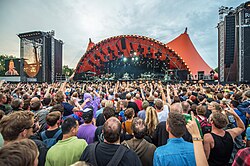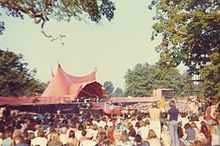
A | B | C | D | E | F | G | H | CH | I | J | K | L | M | N | O | P | Q | R | S | T | U | V | W | X | Y | Z | 0 | 1 | 2 | 3 | 4 | 5 | 6 | 7 | 8 | 9
| Roskilde Festival | |
|---|---|
 | |
| Genre | |
| Dates | Four days, starting from first Wednesday in July, or last Wednesday in June with a 4-day warm-up |
| Location(s) | Roskilde, Denmark |
| Years active | 1971–present |
| Founded by |
|
| Website | roskilde-festival |
The Roskilde Festival is a Danish music festival held annually south of Roskilde. It is one of the largest music festivals in Europe and the largest in the Nordic countries. It was created in 1971 by two high school students and a promoter.[1] In 1972, the festival was taken over by the Roskilde Foundation, which has since run the festival as a non-profit organization for development and support of music, culture and humanism.[2] In 2014, the Roskilde Foundation provided festival participants with the opportunity to nominate and vote upon which organizations should receive funds raised by the festival.
The Roskilde Festival was Denmark's first music-oriented festival created for hippies,[3] and today covers more of the mainstream youth from Scandinavia and the rest of Europe. Most festival visitors are Danes, but there are also many visitors from elsewhere, especially the other Scandinavian countries and Germany.[4]
History
The beginning

The first Roskilde Festival was held on 28 and 29 August 1971, originally named the Sound Festival. It was created by two high schoolers, Mogens Sandfær and Jesper Switzer Møller, and promoter Carl Fischer. It was inspired by festivals and youth gatherings like Newport, Isle of Wight and Woodstock. It was characterized mainly by poor management but also great enthusiasm. The festival's inaugural year saw roughly 20 bands ranging from folk, jazz, rock and pop genres all playing on a single stage, which lasted for two days with some 10,000–13,000 visitors.[5][6] Because of a lack of time and funds, the two high schoolers withdrew and the next year's festival, under the name Fantasy Festival, was arranged by the non-profit Roskilde Foundation and the American folk singer Tony Busch. The foundation had been involved in Roskilde's city festival since 1932 and had the necessary contacts. Unlike the first year, the 1972 festival produced a surplus and the foundation was able to donate 50,000 dkk (equalling c. 330,000 dkk in 2020) to local projects for children and youths. Many volunteers had been involved in the 1972 festival and this, along with being non-profit, would become a hallmark of the future festivals. Since 1973, the Roskilde Foundation (today known as the Roskilde Festival Group) alone has been responsible for arranging the festival.[2]
In 1978, festival organizers acquired the Canopy Scene, an orange musical stage previously used by the Rolling Stones on a European tour. Since its beginning, the Canopy Scene and its characteristic arches have become a well-known symbol and logo representing the festival.[citation needed]
Expansion and professionalization

By the early 1980s, the festival was large and well-established, but the workload had become unmanageable for an organization of all-volunteers. It was decided that a professional board of directors and people in several other fields were necessary. Nevertheless, the festival remains non-profit and still relies heavily on thousands of volunteers.[7]
From the 1980s, there has been an expansion in the music genres represented at the festival and more stages have been added. They have continued their history of hiring a combination of large international bands, local bands, and up-and-coming bands, like U2 in 1981.[7] In the 1990s, electronic music was introduced to the festival. In 1991, Club Roskilde was held, which was an electronic music dance club held in the evenings. In 1995, electronic music artists received their own stage. In the following years, even more room for electronic music was created by the establishment of the chill-out zone and the Roskilde Lounge. Since then, artists like Fatboy Slim, The Prodigy, Basement Jaxx and Chemical Brothers appeared on the main stage.[citation needed]
By the 1990s, the number of tickets offered for sale was restricted and later even reduced. Due to steadily increasing popularity of the festival, the number of visitors had increased to up to 125,000. In addition, 90,000 tickets for about 25,000 volunteers, 5,000 media people and 3,000 artists were added. In order to preserve the quality of the festival, the festival organizers decided to limit the number of participants. The distance from the rearmost part of the camping area to the stages of the festival management seemed to have become unreasonable. The festival had become so popular that the festival management decided in 1994 to expand the festival area to the west, providing more space without increasing distances between the campgrounds and the concert venues. The festival site was now divided by the small railway line into two parts. In 1995 the festival inaugurated its own train station, which facilitates the arrival of visitors.[4] In 1997, another tent called Roskilde Ballroom was built. If Roskilde Festival visitors are included in the population of Roskilde, it is the fourth-largest city in Denmark.[4]
In the 2000s, there has been an increasing focus on the footprint of the festival. In 2017, 90 percent of the food sold in food stalls at the festival was organic and a container-deposit system (expanded compared to the one that already exists in Denmark) has been introduced, which resulted in more than eight million items being returned in that year's festival alone. There are programs for efficient waste sorting, increase of recycling levels, and a reduction of the amount of garbage produced. A partnership with DSB has resulted in more direct train links between the Copenhagen Central Station and the Roskilde Festival station, making it easier to reach by public transport.[4][8]
Stages
This section includes a list of references, related reading, or external links, but its sources remain unclear because it lacks inline citations. (September 2021) |


The bands presented at Roskilde Festival are traditionally a balanced mix of large, well-known artists, cutting-edge artists from all contemporary genres, popular crowd-pleasing acts plus local Scandinavian headliners and up-and-coming names.
The stages were until 2003 named after their colour, but as the names had not matched the actual color of the tents for a period, it was decided to rename all stages except the Orange Stage, the central and main stage. The Orange Stage is open in front of a huge field, whereas the other tents cover the whole audience, the largest of which is the Arena stage (formerly known as Green Stage), the largest tent in Europe with an official capacity of 17,000 people. The 2007 edition saw two new tents, replacing Ballroom (1997–2006) which presented mainly World music, and Metropol (2003–2006) which presented mainly Electronica. In 2010 two stages, Astoria (from 2007) and Lounge, did not return, due to a slight shift in focus towards fewer, but bigger bands. In 2014 the Odeon stage was cancelled along with the surrounding sustainable-style food outlets, and the area was replaced with pre-booked tents for festival guests that prefer not to bring their own.
The music covers such styles as rock, Hip Hop, Metal, urban, electronica and 3rd world contemporary music. It has become a tradition to let a Danish act open the Orange Stage on the first day of the festival. There are often surprising performances by classical acts, film-music, opera etc.
Apart from music there is always some theatre and 'lone acts' wandering around the festival site. Terrain and tents are always decorated in various ways. The current tents are:
| Stage name | Year introduced | Capacity | Main genres | Replaced |
|---|---|---|---|---|
| Orange | 1978 | 60,000+ | All | Big Stage |
| Arena | 2003 | 17,000 | All | Green Stage |
| Avalon | 2014 | 6,000 | Hip Hop, Electronica, Urban world music, Metal | Cosmopol/Odeon |
| Apollo | 2012 | 5,000 | Electronica | |
| Pavilion | 2003 | 2,000 | Mixed, mostly rock-ish | Blue Stage |
| Gloria | 2011 | 1,000 | Mixed | |
| Other | ||||
| Countdown | 2012 | 5,000 | Electronica | |
| Rising | 2014 | 5,000 | Mixed – only up and coming Nordic acts | Pavilion Junior |
| East | 2017 |
Campsite
The festival campsite covers nearly 80 hectares (200 acres) and access to it is included in the ticket price. It usually opens on Saturday afternoon prior to the festival itself. Apart from the small and separate Camping South it is divided into two areas, East and West, each comprising a service center with establishments ranging from food stalls to a cinema. The campsite is further divided into 'agoras' that provide toilets, cell phone charging and luggage storage. They also host events according to each agora's theme.[citation needed]
As of 2018, a new gate system has been installed. This means that all guests arriving first fill 7 rows of the gate system (1000 people in each). Behind this, a large field holding all remaining guests. At 16:00 on the opening Saturday, the gates open, one row at a time at approx 90sec intervals. Once this is complete, the remaining guest in the back area are free to enter the camping area. The concert sites only open the following day.[9]
Every year since 1999, on the Saturday of the festival (held on a Thursday in 2015, 2016 and 2017), Roskilde Festival Radio organizes a naked run in a fenced-in track around the camp site. One male and one female winner receive a ticket for the next year's festival.[10] The run has subsequently become a very popular and "legendary" part of the festival.[11]
Newspaper

The Orange Press (named after the main stage) was a newspaper that specifically dealt with events relevant to the festival. First published in 2008, it was made by more than 70 journalists, photographers and music reviewers. It was published daily during the festival and available online and on-site for free until its last issue in 2022.[12][13] The festival has since decided to focus more on digital communication.


